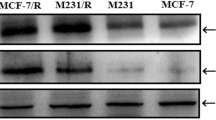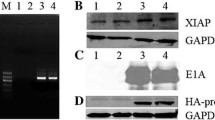Abstract
Purpose
Oncolytic virotherapy is emerging as an important modality in cancer treatment. In a previous study, we designed and constructed Ad-Apoptin-hTERTp-E1a (Ad-VT), a dual cancer-selective anti-tumor recombinant adenovirus.
Methods
To explore the therapeutic effect of recombinant adenovirus Ad-VT together with Etoposide on small cell lung cancer, the ability of Ad-VT alone, Etoposide alone, and a combination of Ad-VT + Etoposide to inhibit proliferation of NCI-H446 and BEAS-2B cells was investigated using the WST-1 method. According to the inhibitory action of different combinations, a combination index (CI) was estimated by CalcuSyn software to select the best combination. The inhibitory effect of Ad-VT combined with Etoposide on NCI-H446 and BEAS-2B cells was detected by crystal violet staining and the CFST method. Hoechst, Annexin V and JC-1 staining were used to explore the inhibitory pathway of Ad-VT combined with Etoposide on NCI-H446 cells. The migratory and invasive abilities of treated NCI-H446 cells were assessed by Transwell and BioCat methods. Tumor volume, body weight and survival rate were measured to analyze the anti-tumor and toxic effects of different treatments in tumor-bearing mice.
Results
Ad-VT (20 MOI) combined with Etoposide (400 nM) significantly inhibited NCI-H446 cell proliferation with reduced toxicity of Etoposide to normal cells. Ad-VT induced apoptosis of NCI-H446 cells mainly through the mitochondrial apoptosis pathway, an effect significantly increased by the combined treatment. Ad-VT together with Etoposide significantly inhibited migration and invasion of NCI-H446 cells, inhibited tumor growth in vivo and prolonged the survival of tumor-bearing mice.
Conclusions
The above results indicate that when combined with Etoposide, Ad-VT may have an important role in synergistically inhibiting tumors.






Similar content being viewed by others
Availability of data and materials
The datasets used and/or analyzed during the current study are available from the corresponding author on reasonable request.
References
Antonia SJ, Lopez-Martin JA, Bendell J, Ott PA, Taylor M, Eder JP, Jager D, Pietanza MC, Le DT, de Braud F, Morse MA, Ascierto PA, Horn L, Amin A, Pillai RN, Evans J, Chau I, Bono P, Atmaca A, Sharma P, Harbison CT, Lin CS, Christensen O, Calvo E (2016) Nivolumab alone and nivolumab plus ipilimumab in recurrent small-cell lung cancer (CheckMate 032): a multicentre, open-label, phase 1/2 trial. Lancet Oncol 17:883–895
Bade BC, Dela Cruz CS, Cancer L (2020) Epidemiology, etiology, and prevention. Clin Chest Med 41(2020):1–24
Balkwill F (2009) Tumour necrosis factor and cancer. Nat Rev Cancer 9:361–371
Bray F, Ferlay J, Soerjomataram I, Siegel RL, Torre LA, Jemal A, Global Cancer Statistics (2018) GLOBOCAN estimates of incidence and mortality worldwide for 36 cancers in 185 countries. CA Cancer J Clin 68(2018):394–424
Byers LA, Rudin CM (2015) Small cell lung cancer: where do we go from here? Cancer 121:664–672
Chiocca EA, Rabkin SD (2014) Oncolytic viruses and their application to cancer immunotherapy. Cancer Immunol Res 2:295–300
Chiocca E, Abbed K, Tatter S, Louis D, Hochberg F, Barker F, Kracher J, Grossman S, Fisher J, Carson K, Rosenblum M, Mikkelsen T, Olson J, Markert J, Rosenfeld S, Nabors L, Brem S, Phuphanich S, Freeman S, Kaplan R, Zwiebel J (2004) A phase I open-label, dose-escalation, multi-institutional trial of injection with an E1B-attenuated adenovirus, ONYX-015, into the peritumoral region of recurrent malignant gliomas, in the adjuvant setting. Mol Ther J Am Soc Gene Ther 10:958–966
Danen-Van Oorschot AAAM, Zhang YH, Leliveld SR, Rohn JL, Seelen MCMJ, Bolk MW, Van Zon A, Erkeland SJ, Abrahams JP, Mumberg D, Noteborn MHM (2003) Importance of nuclear localization of apoptin for tumor-specific induction of apoptosis. J Biol Chem 278:27729–27736
Fruh M, De Ruysscher D, Popat S, Crino L, Peters S, Felip E, E.G.W. Group (2013) Small-cell lung cancer (SCLC): ESMO clinical practice guidelines for diagnosis, treatment and follow-up. Ann Oncol 24(Suppl 6):vi99–vi105
Fulci G, Chiocca E (2003) Oncolytic viruses for the therapy of brain tumors and other solid malignancies: a review. Front Biosci 8:e346-360
Gu D, Kelly TN, Wu X, Chen J, Samet JM, Huang JF, Zhu M, Chen JC, Chen CS, Duan X, Klag MJ, He J (2009) Mortality attributable to smoking in China. N Engl J Med 360:150–159
Heilman DW, Teodoro JG, Green MR (2006) Apoptin nucleocytoplasmic shuttling is required for cell type-specific localization, apoptosis, and recruitment of the anaphase-promoting complex/cyclosome to PML bodies. J Virol 80:7535–7545
Hirvinen M, Rajecki M, Kapanen M, Parviainen S, Rouvinen-Lagerström N, Diaconu I, Nokisalmi P, Tenhunen M, Hemminki A, Cerullo V (2015) Immunological effects of a tumor necrosis factor alpha-armed oncolytic adenovirus. Hum Gene Ther 26:134–144
Kemeny N, Brown K, Covey A, Kim T, Bhargava A, Brody L, Guilfoyle B, Haag N, Karrasch M, Glasschroeder B, Knoll A, Getrajdman G, Kowal K, Jarnagin W, Fong Y (2006) Phase I, open-label, dose-escalating study of a genetically engineered herpes simplex virus, NV1020, in subjects with metastatic colorectal carcinoma to the liver. Hum Gene Ther 17:1214–1224
Liu L, Wu W, Zhu G, Liu L, Guan G, Li X, Jin N, Chi B (2012) Therapeutic efficacy of an hTERT promoter-driven oncolytic adenovirus that expresses apoptin in gastric carcinoma. Int J Mol Med 30:747–754
Ng KK, Vauthey JN, Pawlik TM, Lauwers GY, Regimbeau JM, Belghiti J, Ikai I, Yamaoka Y, Curley SA, Nagorney DM, Ng IO, Fan ST, Poon RT, C. International Cooperative Study Group on Hepatocellular (2005) Is hepatic resection for large or multinodular hepatocellular carcinoma justified? Results from a multi-institutional database. Ann Surg Oncol 12:364–373
Noteborn MH, Koch G (1995) Chicken anaemia virus infection: molecular basis of pathogenicity. Avian Pathol J WVPA 24:11–31
Noteborn MHM, De Boer GF, Van Roozelaar DJ, Karreman C, Kranenburg O, Vos JG, Jeurissen SHM, Hoeben RC, Zantema A, Koch G, Van Ormondt H, Van Der Eb AJ (1991) Characterization of cloned chicken anemia virus DNA that contains all elements for the infectious replication cycle. J Virol 65:3131–3139
Noteborn MH, Todd D, Verschueren CA, deGauw HW, Curran WL, Veldkamp S, Douglas AJ, McNulty MS, van der EA, Koch G (1994) A single chicken anemia virus protein induces apoptosis. J Virol 68:346–351
Phenix KV, Meehan BM, Todd D, McNulty MS (1994) Transcriptional analysis and genome expression of chicken anaemia virus. J Gen Virol 75(Pt 4):905–909
Qi Y, Guo H, Hu N, He D, Zhang S, Chu Y, Huang Y, Li X, Sun L, Jin N (2014) Preclinical pharmacology and toxicology study of Ad-hTERT-E1a-Apoptin, a novel dual cancer-specific oncolytic adenovirus. Toxicol Appl Pharmacol 280:362–369
Qian Y, Yang L, Cao S (2014) Telomeres and telomerase in T cells of tumor immunity. Cell Immunol 289:63–69
Reed LJ, Meunch H (1938) A simple method of estimating fifty percent endpoints. Am J Hyg 27:493–497
Rohn JL, Zhang YH, Aalbers RIJM, Otto N, Den Hertog J, Henriquez NV, Van de Velde CJH, Kuppen PJK, Mumberg D, Donner P, Noteborn MHM (2002) A tumor-specific kinase activity regulates the viral death protein apoptin. J Biol Chem 277:50820–50827
Sato-Dahlman M, Yamamoto M (2018) The development of oncolytic adenovirus therapy in the past and future—for the case of pancreatic cancer. Curr Cancer Drug Targets 18:153–161
Sung H, Ferlay J, Siegel RL, Laversanne M, Soerjomataram I, Jemal A, Bray F (2021) GLOBOCAN estimates of incidence and mortality worldwide for 36 cancers in 185 countries. CA Cancer J Clin 71:209–249
Umar A, Dunn BK, Greenwald P (2012) Future directions in cancer prevention. Nat Rev Cancer 12:835–848
Wang H, Satoh M, Chen GP, Li DC, Hamada H, Arai Y (2011) E1A, E1B double-restricted adenovirus enhances the cytotoxicity and antitumor activity of gemcitabine to renal cell carcinoma. Chin Med J 124:1082–1087
Xiao L, Yan L, Zhongmei W, Chang L, Huijun L, Mingyao T, Kuoshi J, Lili S, Pegn G, Encheng Y, Xiaohong X, Shifu K, Zhuoyue W, Yuhang W, Ningyi J (2010) Potent anti-tumor effects of a dual specific oncolytic adenovirus expressing apoptin in vitro and in vivo. Mol Cancer 9:10
Yang G, Meng X, Sun L, Hu N, Jiang S, Sheng Y, Chen Z, Zhou Y, Chen D, Li X, Jin N (2015) Antitumor effects of a dual cancer-specific oncolytic adenovirus on colorectal cancer in vitro and in vivo. Exp Ther Med 9:327–334
Yoo JY, Kim JH, Kwon YG, Kim EC, Kim NK, Choi HJ, Yun CO (2007) VEGF-specific short hairpin RNA-expressing oncolytic adenovirus elicits potent inhibition of angiogenesis and tumor growth. Mol Ther 15:295–302
Zhang M, Wang J, Li C, Hu N, Wang K, Ji H, He D, Quan C, Li X, Jin N, Li Y (2013) Potent growth-inhibitory effect of a dual cancer-specific oncolytic adenovirus expressing apoptin on prostate carcinoma. Int J Oncol 42:1052–1060
Zhang D, Xiao YF, Zhang JW, Xie R, Hu CJ, Tang B, Wang SM, Wu YY, Hao NB, Yang SM (2015) miR-1182 attenuates gastric cancer proliferation and metastasis by targeting the open reading frame of hTERT. Cancer Lett 360:151–159
Acknowledgements
The authors would like to express their gratitude to EditSprings (https://www.editsprings.cn/) for the expert linguistic services provided.
Funding
This work was supported by the Jilin Province Youth Scientific and Technological Talent Support Project (Grant No. QT202111).
Author information
Authors and Affiliations
Contributions
Conceived and designed the experiments: TL, XL, LS and GZ. Performed the experiments: TL, JC, YL, XL, YZ, GS, SL, ZX, YL, and NJ. Analyzed the data: TL, XL, LS and GZ. Contributed reagents/materials/analysis tools: YL, XL, YZ, SL, ZX, ZX, and TL. Wrote the paper: TL and XL. All the authors read and approved the final manuscript.
Corresponding authors
Ethics declarations
Conflict of interest
The authors declare that they have no conflict of interests.
Ethics approval and consent to participate
The animal study was reviewed and approved by the Institutional Animal Care and Use Committee (IACUC) of the Changchun University of Chinese Medicine.
Consent for publication
Not applicable.
Additional information
Publisher's Note
Springer Nature remains neutral with regard to jurisdictional claims in published maps and institutional affiliations.
Rights and permissions
About this article
Cite this article
Li, T., Fang, J., Chu, J. et al. In vivo and in vitro inhibition of SCLC by combining dual cancer-specific recombinant adenovirus with Etoposide. J Cancer Res Clin Oncol 148, 1073–1085 (2022). https://doi.org/10.1007/s00432-021-03899-7
Received:
Accepted:
Published:
Issue Date:
DOI: https://doi.org/10.1007/s00432-021-03899-7




